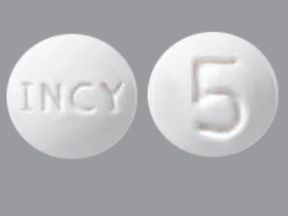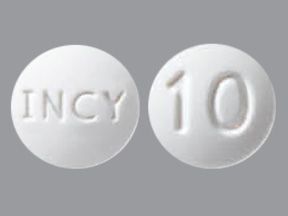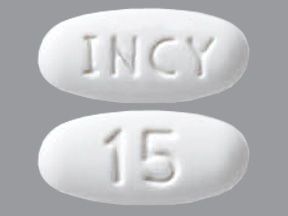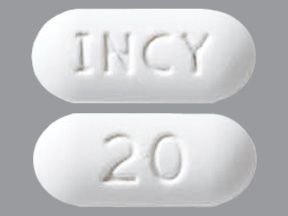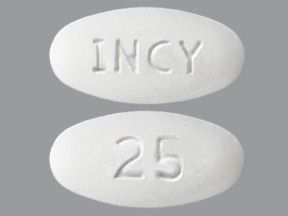If you have a certain kind of cancer or graft-versus-host disease (GVHD), your doctor might suggest Jakafi as a treatment option. It’s a prescription drug used to treat the following conditions:
- myelofibrosis (a kind of bone marrow cancer) in certain adults
- polycythemia vera (a kind of blood cancer) in certain adults
- acute and chronic GVHD in certain adults and some children
Jakafi comes as a tablet you swallow. It contains the active ingredient ruxolitinib. (An active ingredient is what makes a drug work.) It belongs to a group of drugs called kinase inhibitors.
This article describes the dosages of Jakafi, as well as its strengths and how to take it. To learn more about Jakafi, see this in-depth article.
Note: This article covers Jakafi’s usual dosages, which are provided by the drugmaker. But when using Jakafi, always take the dosage your doctor prescribes.
The chart below highlights the basics of Jakafi’s dosage. Be sure to read on for more detail.
| Condition | Starting dosage |
| myelofibrosis | depends on platelet count |
| polycythemia vera | 10 milligrams (mg) twice per day |
| acute graft-versus-host disease | 5 mg twice per day |
| chronic graft-versus-host disease | 10 mg twice per day |
What is Jakafi’s form?
Jakafi comes as a tablet you swallow.
What strengths does Jakafi come in?
Jakafi comes in the following strengths: 5 mg, 10 mg, 15 mg, 20 mg, and 25 mg.
What are the usual dosages of Jakafi?
Your doctor will likely start you on a lower dosage and adjust it over time to reach the right amount for you. They’ll ultimately prescribe the smallest dosage that provides the desired effect.
The information below describes dosages that are commonly used or recommended. But be sure to take the dosage your doctor prescribes for you. They’ll determine the best dosage to fit your needs.
Dosage for graft-versus-host disease (GVHD)
The starting dosage for GVHD differs based on whether your GVHD is acute or chronic.
Dosage for acute GVHD
The starting dosage for acute GVHD is 5 mg twice per day. Your doctor may increase your dosage to 10 mg twice per day after 3 days of treatment. They’ll monitor your platelets and white blood cell counts before increasing your dose.
Dosage for chronic GVHD
The starting dosage for chronic GVHD is 10 mg twice per day.
Dosage for polycythemia vera
The starting dosage for polycythemia vera is 10 mg twice per day.
Dosage for myelofibrosis
The starting dosage for myelofibrosis depends on your platelet count, as outlined in the table below.
| Platelet count | Starting dosage |
| greater than 200 x 109/liter (L) | 20 mg twice per day |
| 100 x 109/L to 200 x 109/L | 15 mg twice per day |
| 50 x 109/L to less than 100 x 109/L | 5 mg twice per day |
What’s the dosage of Jakafi for children?
Jakafi is approved to treat acute and chronic GVHD in children ages 12 years and older. The starting dosage is the same as that for adults, 5 mg twice per day (acute) or 10 mg twice per day (chronic). Their doctor will adjust their dose as needed to find what works best for them.
Is Jakafi used long term?
Yes, Jakafi is usually used as a long-term treatment. If you and your doctor determine that it’s safe and effective for your condition, you’ll likely take it long term.
In some situations, Jakafi may be stopped and restarted. Talk with your doctor about how long you’re likely to take this drug.
Dosage adjustments
Your doctor may adjust your dosage of Jakafi if you have certain conditions related to kidney or liver function. They may also adjust it based on your platelet count or changes in other lab test results.
Other factors can also affect the dosage you’re prescribed. See “What factors can affect my dosage?” below for details.
Below are answers to some commonly asked questions about Jakafi’s dosage.
Can Jakafi be cut in half or split?
You should not cut Jakafi in half or split the tablet. Tablets should be swallowed whole. If you have difficulty swallowing tablets, check out this article or talk with your doctor. Jakafi can be given through certain nasogastric tubes.
What is the usual duration (length) of treatment with Jakafi?
How long your doctor recommends you take Jakafi depends on several factors. These include how well the drug is working for you and the condition you’re using it to treat.
Talk with your doctor about how long you can expect to take Jakafi.
The dosage of Jakafi you’re prescribed may depend on several factors. These include:
- the type and severity of the condition you’re taking the drug to treat
- if you’re stopping then restarting treatment
- kidney function
- liver function
- platelet count or changes in other lab test results
- poor response (Jakafi isn’t working for you)
- other medications you take
- bleeding or other side effects
- other conditions you may have
Jakafi comes as a tablet that should be swallowed whole. You can take Jakafi with or without food.
If you have trouble swallowing tablets, see this article for tips on how to take this form of medication. If you cannot swallow tablets, talk with your doctor. Jakafi can be given through certain nasogastric tubes.
For information on the expiration, storage, and disposal of Jakafi, see this article.
Accessible drug containers and labels
If you find it hard to read the prescription label on your medication, tell your doctor or pharmacist. Some pharmacies provide medication labels that:
- have large print or use braille
- feature a code you can scan with a smartphone to change the text to audio
Your doctor or pharmacist may be able to recommend pharmacies that offer these accessibility features if your current pharmacy doesn’t.
If you have trouble opening medication bottles, let your pharmacist know. They may be able to supply Jakafi in an easy-open container. They may also have tips to help make it simpler to open the drug’s container.
If you miss a dose of Jakafi, do not take the missed dose. Wait to take your next dose of Jakafi at your scheduled time.
If you need help remembering to take your dose of Jakafi on time, try using a medication reminder. This can include setting an alarm or downloading a reminder app on your phone.
Do not take more Jakafi than your doctor prescribes, as this can lead to serious side effects.
Symptoms of overdose
Symptoms caused by an overdose can include:
- decreased white blood cells
- anemia (low level of red blood cells)
- decreased platelets
What to do in case you take too much Jakafi
Call your doctor right away if you think you’ve taken too much Jakafi. You can also call 800-222-1222 to reach the American Association of Poison Control Centers or use its online resource. But if you have severe symptoms, immediately call 911 (or your local emergency number) or go to the nearest emergency room.
The sections above describe the usual dosages provided by the drugmaker. If your doctor recommends Jakafi, they’ll prescribe the dosage that’s right for you.
Remember, you should not change your dosage of Jakafi without your doctor’s recommendation. Only take Jakafi exactly as prescribed. Talk with your doctor if you have questions or concerns about your current dosage. Here are some examples of questions you may want to ask them:
- Will a higher dosage of Jakafi increase my risk of side effects?
- Can I take other medications while taking Jakafi?
- Will my Jakafi starting dosage be different if I’ve taken it before?
To get information on different conditions and tips for improving your health, subscribe to any of Healthline’s newsletters. You may also want to check out the online communities at Bezzy. It’s a place where people with certain conditions can find support and connect with others.
Disclaimer: Healthline has made every effort to make certain that all information is factually correct, comprehensive, and up to date. However, this article should not be used as a substitute for the knowledge and expertise of a licensed healthcare professional. You should always consult your doctor or another healthcare professional before taking any medication. The drug information contained herein is subject to change and is not intended to cover all possible uses, directions, precautions, warnings, drug interactions, allergic reactions, or adverse effects. The absence of warnings or other information for a given drug does not indicate that the drug or drug combination is safe, effective, or appropriate for all patients or all specific uses.

